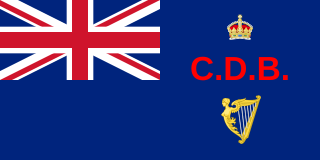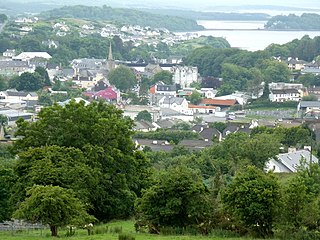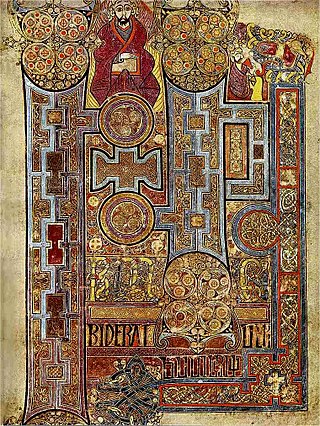
County Donegal is a county of Ireland in the province of Ulster and in the Northern and Western Region. It is named after the town of Donegal in the south of the county. It has also been known as County Tyrconnell or Tirconaill, after the historic territory. Donegal County Council is the local council and Lifford is the county town.

The Book of Durrow is an illuminated manuscript gospel book dated to c. 700 that contains the Vulgate Latin text of the four Gospels, with some Irish variations, and other matter, written in Insular script, and richly illustrated in the style of Insular art with four full-page Evangelist symbols, six carpet pages, and many decorated initials.

Letterkenny, nicknamed the Cathedral Town, is a large town in County Donegal, Ireland, on the River Swilly in the north-west of Ulster. Along with the nearby city of Derry, Letterkenny is a regional economic gateway for the north-west of Ireland.

St Eunan's Cathedral, or the Cathedral of St Eunan and St Columba as it is also known, is a cathedral in the parish of Conwal and Leck, part of the Diocese of Raphoe. Built between the years of 1890 and 1900, the cathedral is found in Letterkenny, County Donegal in Ireland. There are two cathedrals in the county; an older cathedral of the same name is found in the town of Raphoe, and since the Reformation, has been used by the Church of Ireland.

Lifford is the county town of County Donegal, Ireland, the administrative centre of the county and the seat of Donegal County Council, although the town of Letterkenny is often mistaken as holding this role.

Roscrea is a market town in County Tipperary, Ireland. In 2022 it had a population of 5,542. Roscrea is one of the oldest towns in Ireland, having developed around the 7th century monastery of Saint Crónán of Roscrea, parts of which remain preserved today. The town is in a civil parish of the same name.

The Congested Districts Board for Ireland was established by Arthur Balfour, the Chief Secretary for Ireland, in 1891 to alleviate poverty and congested living conditions in the west and parts of the northwest of Ireland.

Donegal is a town in County Donegal in Ulster, the northern province in Ireland. Although Donegal gave its name to the county, now Lifford is the county town. From the 15th until the early 17th century, Donegal was the "capital" of Tyrconnell, a Gaelic kingdom controlled by the O'Donnell dynasty of the Northern Uí Néill. The town is in a civil parish of the same name.

Killybegs is a town in County Donegal, Ireland. It is the largest fishing port in the country and on the island of Ireland. It is located on the south coast of the county, north of Donegal Bay, near Donegal Town. Its Irish name Na Cealla Beaga means 'little cells', a reference to early monastic settlements. The town is situated at the head of a scenic harbour and at the base of a vast mountainous tract extending northward. In the summer, there is a street festival celebrating the fish catches and incorporating the traditional "Blessing of the Boats". As of 2022, the population was 1,258.

Buncrana is a town in Inishowen in the north of County Donegal in Ulster, the northern province in Ireland. The town sits on the eastern shores of Lough Swilly, being 23 kilometres (14 mi) northwest of Derry and 43 kilometres (27 mi) north of Letterkenny. In the 2022 census, the population was 6,971, making it the second most populous town in County Donegal, after Letterkenny, and the largest in Inishowen.

Gweedore is a Gaeltacht (Irish-speaking) district and parish located on the Atlantic coast of County Donegal in the north-west of Ireland. Gweedore stretches some 26 kilometres (16 mi) from Glasserchoo and Bloody Foreland in the north to Crolly in the south and around 14 kilometres (9 mi) from Dunlewey in the east to Magheraclogher and Magheralosk in the west, and is sometimes described as one of Europe's most densely populated rural areas. It is the largest Irish-speaking parish in Ireland with a population of around 4,065, and is also the home of the northwest regional studios of the Irish-language radio service RTÉ Raidió na Gaeltachta, as well as an external campus of the University of Galway. Gweedore includes the settlements of Brinlack, Bunbeg, Derrybeg, Crolly and Dunlewey, and sits in the shade of County Donegal's highest peak, Errigal.

Raphoe is a small town in County Donegal in the north-west of Ulster, the northern province in Ireland. It is the main town in the fertile district of East Donegal known as the Laggan. It gave its name to the Barony of Raphoe, which was later divided into the baronies of Raphoe North and Raphoe South, as well as to the Roman Catholic Diocese of Raphoe and the Church of Ireland (Anglican) Diocese of Derry and Raphoe. There is also a civil parish of Raphoe.

The Cathedral Church of St. Colman, usually known as Cobh Cathedral, or previously Queenstown Cathedral, is a single-spire cathedral in Cobh, Ireland. It is a Roman Catholic cathedral and was completed in 1919. Built on Cathedral Place, it overlooks Cork harbour from a prominent position, and is dedicated to Colmán of Cloyne, patron saint of the Diocese of Cloyne. It serves as the cathedral church of the diocese.

Magee of Donegal are a textile manufacturer, clothing manufacturer and retailer, and manufacturer and retailer of home goods based in Donegal Town, County Donegal, Ireland. The company are known for their woolen Donegal tweed, but also manufacture items from linen, cashmere, silk and other materials.

Insular art, also known as Hiberno-Saxon art, was produced in the post-Roman era of Great Britain and Ireland. The term derives from insula, the Latin term for "island"; in this period Britain and Ireland shared a largely common style different from that of the rest of Europe. Art historians usually group Insular art as part of the Migration Period art movement as well as Early Medieval Western art, and it is the combination of these two traditions that gives the style its special character.

Killygordon is a small village in the Finn Valley in the east of County Donegal, Ireland. As of 2022, the population was 716. It is located on the N15 between Stranorlar and Castlefin. The separate hamlet and townland of Crossroads, usually known as The Cross, lies half a mile from Killygordon. The River Finn passes by the village on its way towards its confluence with the River Mourne and the River Foyle.
The Dun Emer Guild (1902–1964) was an Irish Arts and Crafts textile studio founded in 1902 by Evelyn Gleeson, initially in partnership with Elizabeth and Lily Yeats as Dun Emer Industries and Press.

Alexander Morton was a Scottish textiles manufacturer.


















